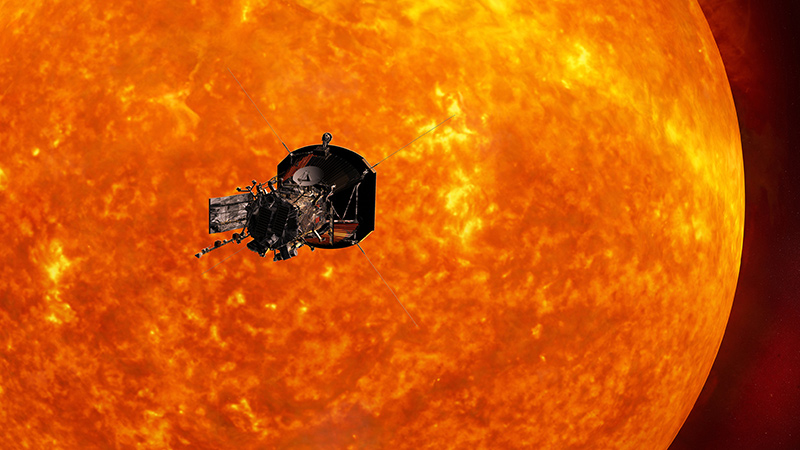Stay Up to Date
Submit your email address to receive the latest industry and Aerospace America news.
Eugene Parker honored with medal for predicting solar eruptions that threaten Earth
NASA on Wednesday gave a new name to the spacecraft it plans to launch next year on a mission that will take it on a record-setting close approach to the sun: the Parker Solar Probe.
The name honors heliophysicist Eugene Parker, 89, a professor emeritus at the University of Chicago who in 1958 predicted the existence of the solar wind, charged particles from the sun that course through our solar system. NASA says the Parker Solar Probe is the first spacecraft named after a researcher during his lifetime.
The Parker probe will be launched on a Delta 4 Heavy rocket between July 31 and August 19 in 2018 on a trajectory that eventually will send it within 6.4 million kilometers of the surface of the sun, which is seven times closer than any other spacecraft has come.
By flying through the sun’s corona, or atmosphere, the probe could uncover how to predict eruptions of subatomic particles that can travel at speeds up to 3.2 million kph and threaten to disable Earth’s critical satellites and power grids. A massive solar storm in 2012, caused by a coronal mass ejection, could have caused devastating blackouts and damage to vital technology like GPS signals, but the superstorm narrowly missed Earth’s orbit, NASA has said.
Thomas Zurbuchen, associate administrator of NASA’s Science Mission Directorate, said during a press conference at the University of Chicago that Parker’s research proposing solar winds was controversial before the Mariner 2 probe launched in 1962 proved it correct. He added that “many great discoveries” are controversial at first. During the press conference, scientists outlined the 2018 mission, and Zurbuchen presented Parker with the NASA distinguished service medal. Parker will also be able to choose an inscription to write on the probe, which will contain photographs and copies of his research.
“I’m greatly honored to be associated with this heroic space mission,” Parker said.
He called the mission “heroic” because the probe bearing his name will fly through the corona, which is mysteriously 300 times hotter than the surface of the sun. Johns Hopkins University Applied Physics Laboratory in Maryland is building the probe, including an 11.4 centimeter thick carbon-composite heat shield, and testing its software to ensure the spacecraft and everything inside it can withstand the intense heat of the sun’s outer atmosphere, which can reach 1,377 degrees Celsius.
The mission to learn the mysteries of the sun’s atmosphere up close was impossible for decades because materials didn’t yet exist that could keep the probe from overheating, said Nicola Fox, mission project scientist working on the probe at APL.
Thanking Parker for his “revolutionary work,” Fox said the up-close mission is necessary for deeper understanding of solar wind and questions like: “Why is the corona hotter than the surface of the sun?”
“That defies the laws of nature, it’s like water flowing uphill,” Fox said.
The Parker probe will orbit the sun 24 times, and during its journey it will make seven flights by Venus, whose gravity will slow the probe to make it sink deeper into the sun’s corona.
The two probes of the Solar Terrestrial Relations Observatory, nicknamed STEREO, also launched in 2006 into orbits on opposite sides of the sun to make a 3-D rendering of eruptions coming from its surface.
About Tom Risen
As our staff reporter from 2017-2018, Tom covered breaking news and wrote features. He has reported for U.S. News & World Report, Slate and Atlantic Media.
Related Posts
Stay Up to Date
Submit your email address to receive the latest industry and Aerospace America news.




